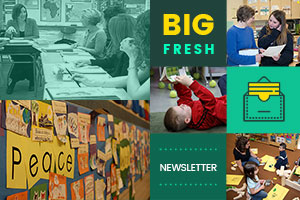Without a sense of caring, there can be no sense of community.
Anthony J. D’Angelo
It’s transition time in kindergarten. The lights are dim and the room is quiet. Children are picking up blocks and crayons and books. They place things back in order gently and then find a seat on the carpet. The teacher says, “We are going to share our learning. It’s okay if you’re not quite finished with tidying your area. Take your time.” The students on the rug shift their attention to a classmate who brings a large piece of paper from the windowsill to the meeting area. Sharing begins.
My attention, however, is in the kitchen area where two girls are restoring order. Each item is placed in the proper place. They work silently, and with intention. They are not rushed, but they are efficient.
I am captivated by their care.
As I watch, my mind rewinds to many years ago when I sat in a foster care licensing class. The instructor said, “Humans must learn to care.” I thought it was an odd sentiment. Learn to care? Aren’t humans wired to care? The instructor went on to say that when children are well nourished and live in loving homes, they organically learn to care.
I realized that caring isn’t something that just happens. It is learned. At first the idea seemed foreign, but then I began living with children who needed to learn to care. It is true: humans must learn to care.
The children tidying the kitchen are an inspiration to me. They are not intent on moving to the next thing. They linger in the moment and care about the current work. So often I rush through the daily grind with the intention of finishing fast and moving on. There are times when I need to learn to care, too. In a hurry-up world, the greatest gift we can give children is time to care. I am reminded that it begins within us.
This week we look at how to analyze and write about characters in classrooms. Plus more as always—enjoy!
Ruth Ayres
Lead Contributor, Choice Literacy

Melanie Meehan shares activities that help students talk about their characters before writing about them in a realistic fiction unit.
Tammy Mulligan shares her four favorite mentor texts for understanding students who are angry and lash out.
You can meet many of your favorite Choice Literacy writers this summer at The Lead Learners Summer Institute in Warsaw, Indiana on June 22-23. Choice Literacy members receive discounts of 20-40% off the institute fee based on your membership tier. For more information on presenters and workshop descriptions, click here.

New members-only content is added each week to the Choice Literacy website. If you’re not yet a member, click here to explore membership options.
Jennifer Allen upends the normal routines in a primary writing workshop to introduce students to a compelling character.
In this week’s video, Dana Murphy meets with a group of fifth graders to explore character development in their reading.
Teaching comprehension skills can be a complex and overwhelming task. Tammy Mulligan shares a process for expanding and deepening student interpretations of characters in texts.
In an encore video, Jason DiCarlo leads a lesson in a third-grade classroom about understanding character traits. He begins with a discussion of decisions characters make.

Lead Literacy now has a new home as the Leaders Lounge at Choice Literacy. We’ll be posting the new content updates here in the Leaders Lounge section of the Big Fresh newsletter.
If we want others to change, we first have to be open to change within ourselves. But what does that look like, and how can we embrace the tension that change brings? Matt Renwick explores change from within for literacy leaders.
Principal Lee Snider talks about how he built rapport with teachers when he was new to the role of principal in the building.
Do you work with a teacher or two who just doesn’t fit in? Adam Grant considers the power of misfit for invention and breakthroughs in any community.
Quote It:
The need to change bulldozed a road down the center of my mind.
Maya Angelou
That’s all for this week!



